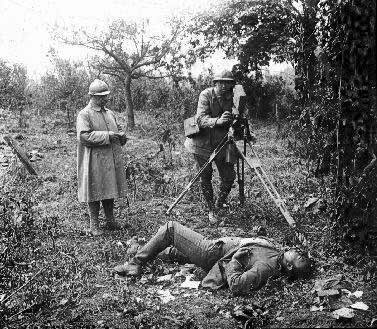The True Face of the Great War
The British officer Julian Grenfell, a professional soldier and a poet who loved the army, his fellow officers and his dogs, wrote to his parents:
"I adore war. It's like a big picnic without the objectlessness of a picnic. I've never been so well or happy. No one grumbles at one for being dirty."
Grenfell wrote the letter in October 1914, shortly after his arrival on the battlefield in Northern France.
His specialty, he revealed, was stalking German snipers and shooting them from very close range. "One loves one's fellow-man so much more when one is bent on killing him", he added.
These were statements the men in power loved. They showed the public that the war was exiting, jolly and worth enlisting for.
One can only wonder how much sooner the war would have ended if the public on both sides could have seen the true face of the battlefields.
Even today the real horrors of this war are kept from us. Pictures in books and publications about the Great War do not show the true face of this war.
Displaying the real picture of the bestiality and the suffering in and out the trenches is still considered "not done" or "unethical".
People therefore often do not realize that the impression they get from current WW1 pictures is not correct, at least incomplete.
Morale
The official war photographers were not supposed to photograph the vast numbers of dead or the ugly way soldiers died. The resason was simple. Their pictures had but one purpose: keeping up morale. Their pictures were checked and destroyed if they set the wrong tone.
Of the five million photographs in the Imperial War Museum in Londen none would give you the impression that there were ever more than a couple of dozen dead to be seen at any one place (click here for such a picture that is not in this museum).
And how silly it may seem: researchers looking for pictures of dead soldiers are still not very welcome in the Imperial War Museum ('We are looked upon as traitors or freaks', one of these scholars wrote).
As a result of this old and new censorship romantic and heroic illusions about the Great War still widely exist. Socalled re-enacting groups even replay war scenes like it was some kind of childrens play.
Some Pictures Survived
Soldiers nor officers were allowed to use or even have cameras at the front:
"As the intention of General Routine Order No.1137 appears in some cases to be misunderstood, it is notified that no Officer or soldier (or other person subject to Military law) is permitted to be in possession of a camera."
Some however, disobeyed this order and took their camera (the small 'Vest Pocket Kodak' was especially populair) with them into the trenches. Some of their pictures survived.
 Still existing too are gruesome stereographic photos made by French war photographers and cinematographers (picture right). Click here for an example.
Still existing too are gruesome stereographic photos made by French war photographers and cinematographers (picture right). Click here for an example.
These stereo pictures can still be viewed in two small WW1-museums in Flanders, Belgium. Originally they were part of one large collection. The Belgian Schier family who owned the collection separated and the pictures were divided between two brothers.
Each of the brothers now exploits his own dusty museum annex café (at Hill 60 and at Hill 62 respectively, southeast of Ypres).
Over the years many of these uniqe pictures have been scratched, torn or broken by the visitors. The pictures won't live long anymore.
War Against War
In Germany, after the war, pacifist and writer Ernst Friedrich, from Berlin, gathered private pictures that showed dead and horribly mutilated soldiers. He published them in 1924 in a book called Krieg dem Kriege (War against War), in the hope that confronting the world with this misery would prevent another war. The book got worldwide attention - but prevented little.
And then there is the work of two British journalists, T.A. Innes and Ivor Castle, who gathered some authentic and horrible photographs that were never published before. They made a book Covenants with Death, that was published in 1934 by the Daily Express in England.
If you click on the link below, we show photographs you won't find easily elsewhere. These pictures are not a pretty sight. Some may shock you. If you think it's bad taste showing them, please consider: what they reveal is still a small part of the suffering in the Great War.
By the way: Julian Grenfell's picnic was soon over. He died from wounds on April 30th, 1915. He was 27 years old.
Click here to see the true face of horror.
![]()
![]() Sources for this article / Bronnen voor dit artikel.
Sources for this article / Bronnen voor dit artikel.
![]() To the Frontpage of the 'Heritage of the Great War'
To the Frontpage of the 'Heritage of the Great War'
![]()